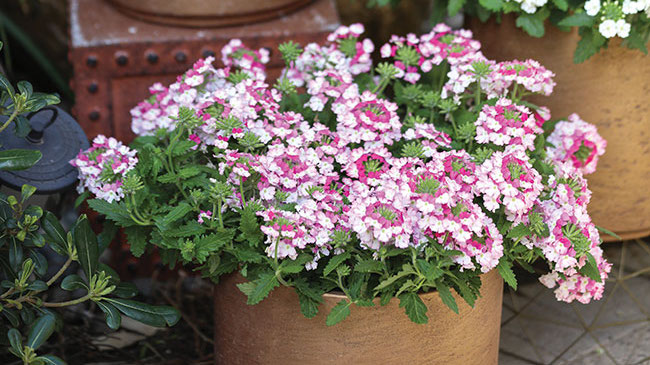
Celebrate the Verbena
There are many reasons to love and grow verbena. It is a versatile crop with many uses, from baskets to the landscape. In recent years, we’ve seen so many new colors introduced in the category, making them an especially eye-catching component in mixed combinations.
This month, I decided to pick the brains of some industry experts well-versed in all things verbena to gain more insight into the crop category. Here’s what they had to say.
GPN: Are you familiar with the National Garden Bureau’s “Year of” program? Do you follow the selected crops each year to keep up with trends in the market?
Lisa Heredia, marketing and key accounts, Danziger: Yes! The program is a great way for our industry to educate, market and promote these crops to our end consumers.
Becky Lacy, product manager, Selecta One, and combination manager, Selecta One/Ball FloraPlant: Ball FloraPlant is happy to support the NGB “Year of” program each launch season, and we highlight our varieties if they fit within a “Year of” class. In fact, this year Ball FloraPlant breeder Laura Masor was the main author of the NGB Verbena overview and history article that appears on their website.
Steve Garvey, head grower, Dallas Johnson Greenhouses: I am familiar with the “Year of” program; unfortunately, spring planning is done almost nine months ahead of current year’s decision. We try to adjust production schedules and we do grow more of the “Year of” where we can.
GPN: In your opinion, why do you think verbena was selected for 2022?
Steve: I like the choice. It is a plant that has had a lot of breeding done over the past couple of years to improve growth habit, disease resistance and color offerings.
Becky: From a breeding company perspective, NGB has chosen to spotlight verbena in 2022 due to recent years’ significant refinement
of the genus down to its most positive traits. Older genetics of verbena are late to flower and require significant amounts of plant growth regulators to control the product to make it attractive enough for the home gardener to buy it at retail. Then, they don’t last all summer long for the consumer.
Modern verbena breeding focuses on being compact, fast to flower, and requirements of no pinch and no PGR. A secondary focus is placed on heat tolerance and flowers that last through a hot summer. With these main pains to focus on, breeding companies have brought dozens of series into the marketplace. Verbena is now one of the most versatile annuals with uses in small pots and large, early and late season, standalone pots and combinations, and even the landscape.
Lisa: Verbena breeding has made great strides over the past several years. I like to say that “this is not your grandmother’s verbena” — it is so much better in every way. Improvements in habit, mildew tolerance and reduction in bloom cycling make it a strong option for gardeners in all regions of the country.
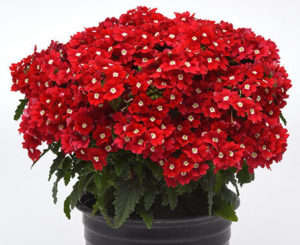
GPN: Over the years, have you witnessed the category evolve?
Steve: Over the past couple of years, I have noticed more options to use in our 4- to 5-inch production and new selections that fit well into our mixed combo planters. The newer varieties have been selected due the different kinds of vigors and different flower colors.
Becky: Breeders like Ball FloraPlant and Selecta One have an extensive lineup of verbena habits and sizes to meet any grower’s needs. All series are heavily screened for powdery mildew resistance and heat tolerance. Beats, the newest series in the Selecta One lineup, is a uniform series with compact vigor and spreading habit. It flowers two weeks earlier than any other verbena. Tolerant to heat, cycling and water stress. No pinch, no PGR. Best in small pots, color bowls and edging in the landscape.
Cadet Upright (Ball FloraPlant) is a true series with compact vigor and an upright habit, best in quart pots.
Lascar (Selecta One) has an extensive color range of medium- vigor verbena with a mounded- trailing habit. Best in hanging baskets, combinations and gallons.
Blues (Selecta One) features large blooms with big “eyes” on a medium-vigor, semi-upright habit. Best in hanging baskets, combinations and gallons.
Firehouse (Ball FloraPlant) is a medium-vigor trailing verbena. Best in hanging baskets, combinations, gallons and smaller landscapes.
EnduraScape (Ball FloraPlant) is best for the landscape due to its vigorous size and spreading habit. It is hardy in Zone 7.
Lisa: Danziger has been breeding and selling verbena for over 20 years. Our modern line of verbena, Vanessa and Vanessa Compact (pictured at top of page), was a breeding project started 11 years ago. Over the past decade or so, this crop has been improved in every way. Verbena were always beautiful and colorful; however, in the past they were a “one and done” crop. They would come into full flower and look great for a short period of time; then they would decline quickly, go out of bloom and get mildew. Many growers were stepping away from growing verbena due to these factors.
New breeding has brought this crop back to life. Growers are trialing new genetics, such as our Vanessa and Vanessa Compact series, and falling in love with verbena all over again as a container plant, hanging basket and for garden beds … and don’t forget the classic PCV [petunia-calibrachoa-verbena] combo. The bicolor options that are available are particularly appealing in combo recipes.

GPN: What has been your primary role in the development of verbena?
Becky: One of my favorite ways to use verbena is in combinations. To a “combination queen” like myself, items that add textural appeal are as important as color.
One of the most tried-and-true trio combination formulas use petunia, calibrachoa and verbena in a single mix: The petunia adds the main color with large blooms, the calibrachoa offers a smaller flowered speckled look, and the verbena adds a circular pop of contrasting color.
A great example of this is Ball FloraPlant’s new MixMasters Great Escape. The verbena in this mix is Ball FloraPlant’s Firehouse Burgundy, which has some of the largest verbena flowers I have ever seen! Two of my other favorite series for creating your own combination baskets are the Lascar and Blues series from Selecta One.
Steve: Verbena has always been a part of our product mix. We use some of the best genetics on the market, which offer us some of the most programmable production and finish. It also offers the end consumer better habits and color choices to use in their successful plantings.
Lisa: I am on the marketing and sales side of things. Our job is to know the market and give the breeders feedback and a breeding “wish list” based on what we know our customers want. After a great deal of hard work by the breeders in Israel and our trial sites around the globe, I am part of the team that makes final selections and decides how to position each plant based on our current lineup and market conditions.
GPN: What makes verbenas special? Do you have any favorite verbena varieties?
Lisa: Verbena are special because they have such great color payoff and I love how they make a solid carpet of bright blooms in a garden bed. My favorite series is Vanessa Compact because it does it all. It is controlled growth so growers can finish a nice small pot with minimal PGR use then it continues to gain size and will make a showy basket or ground cover. My favorite variety is ‘Vanessa Compact Neon Pink’. I swear that you can see that color from a mile away.
Steve: The reason I like verbena is that it is a durable late spring/summer annual. It is very appealing as a monoculture planting or in combination plantings. With selections that vary from upright to trailing it fits in any spot that you are looking to fill. With the wide range of color choices, as well as bi-colors, there is a color and shape for all to enjoy. Empress, Empress Flair and Empress Sun are our go-to lines to produce high-quality material.
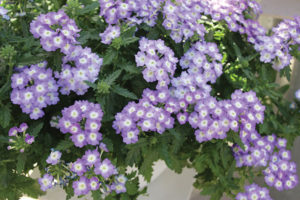
GPN: In what ways can growers and retailers capitalize on the verbena category?
Steve: I think that growers can grow tried-and-true genetics and the new offering from those genetics companies to the retailer and consumer. As a grower we want the best genetics to produce the highest quality crop. This should make the retailer/final consumer feel confident that the verbena they are buying is the latest and greatest out there.
Becky: Growers and retailers who have tried verbena in the past and didn’t succeed should consider trying again with the most recently bred series (see the list above)! They may be surprised at the improvements to the class. Showcasing them in mixes as well helps highlight the texture this class brings to the design table.
Lisa: Use it for everything! The PCV combo is a widely used recipe and has been a classic for a long time for a reason. The texture of verbena blooms blends with the single blooms of the petunia and calibrachoa for a finished effect that consumers love. Play around with different color combinations in a mono three-color planter, mix them with an upright element — just have fun with it. You can also promote it as a colorful option for a groundcover; the possibilities are endless.
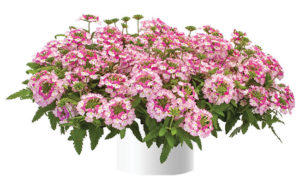
GPN: Does the production or sale of verbena present any challenges for growers or retailers?
Becky: While modern breeding of verbena has done wonders to make the crop more manageable for the grower and consumer, there are still some major challenges yet to be solved. Newer genetics may be improved in these categories but are not perfected.
The first is sensitivity to powdery mildew. Within a series, some colors have superior resistance, while others are very susceptible. Preventative applications of fungicides for mildew are still generally recommended on all verbena from any breeding company.
The second is cycling flowers that go out of color during the summer. While the body of the plant survives and remains healthy and green, the flowers go in and out of bloom. There is a natural ebb and flow of flowers on verbena throughout the season, which can be problematic for late-season sales. Luckily, some series are especially tolerant to this issue.
The third issue plaguing verbena is flower senescence, or flower drop, due to water stress. This issue is especially troubling when growers ship from their greenhouse to the retail centers and when the verbena sits on the shelves at retail. If proper water management is not maintained, the verbena drop their flowers, creating a mess, and leaving the plants green. Nothing creates a larger loss of sales than a flowerless annual! Compact verbena will withstand much higher levels of water stress due to its smaller size, therefore needing less water.
Steve: There are two things that I worry about when producing verbena. The first thing I have to think about is powdery mildew and Botrytis. Producing these crops in the early spring with cooler temps and short days a grower has to use proper chemical/ biocontrols, as well as proper watering procedures to combat these two diseases. The second thing I worry about is thrips. Thrips love verbena and in a greenhouse setting proper scouts and chemical/biocontrol is necessary to produce a high-quality crop.
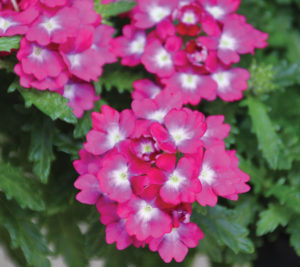
GPN: What attributes make verbena especially appealing to consumers and gardeners?
Steve: I believe that the consumer loves the free flowering, the multiple growth habit choices, and the wide array of color choices that are now offered in the verbena line.
Plus toss in the disease resistance and heat tolerance, and that gives you a great summer performer.
Lisa: It is one of the most colorful plants that a consumer will see in the garden center and really puts on a show when they get it home. Petunias and calibrachoa do that also — but a gal needs options, right?


 Video Library
Video Library 




















